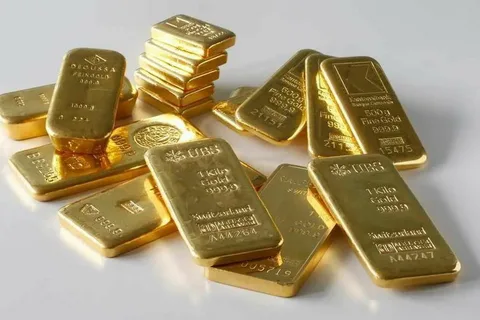The price of gold this year has skyrocketed to unprecedented levels, reaching record highs in 2021. As investors seek safe-haven assets amidst economic uncertainty and market volatility, the demand for gold has surged, driving its price to new peaks. This significant uptick in the price of gold has captured the attention of financial markets worldwide, sparking discussions about the factors contributing to this remarkable increase. In this article, we will explore the reasons behind the soaring price of gold and its implications for the global economy and investment landscape.
The price of gold surged to record highs in 2021 as investors sought safe-haven assets amid economic uncertainty and inflation concerns. In August 2021, gold prices reached over $2,000 per ounce for the first time in history, driven by factors such as geopolitical tensions, government stimulus measures, and a weaker US dollar. These price surges reflect the continued appeal of gold as a store of value and a hedge against market volatility. However, the trajectory of gold prices remains subject to changes in economic conditions, central bank policies, and investor sentiment.
Analyzing the Fluctuating Price of Gold in 2021

The price of gold this year has experienced significant fluctuations, responding to a variety of global events and economic factors. Investors and analysts have been closely monitoring the movement of gold prices in 2021, seeking to understand the driving forces behind these fluctuations and to make informed decisions about their investments. As the year progresses, experts continue to analyze the trajectory of gold prices, considering factors such as inflation, stock market volatility, and historical trends in order to forecast potential outcomes for the rest of the year.
The price of gold in 2021 has been influenced by a range of factors, including the ongoing COVID-19 pandemic, global economic uncertainty, and fluctuations in the stock market. In the first half of the year, gold prices experienced significant volatility, reaching a peak of around $1,900 per ounce in May before declining to around $1,700 per ounce in June. These fluctuations have been driven by changing investor sentiment, inflation concerns, and shifts in demand for safe-haven assets.
Moreover, the Federal Reserve’s monetary policy decisions, particularly regarding interest rates and quantitative easing measures, have also played a role in shaping gold’s price movements. As the year progresses, geopolitical events, such as tensions between major world powers and changes in government policies, are likely to continue impacting the price of gold.
Additionally, the rise of cryptocurrencies and their potential to act as alternative investment vehicles has added another layer of complexity to gold price movements. As investors assess the relative merits of gold and digital assets, the dynamics of the precious metals market have continued to evolve.
Overall, the fluctuating price of gold in 2021 reflects a broader environment of economic uncertainty and changing investment trends, highlighting the importance of ongoing analysis and monitoring of the factors driving these fluctuations.
The Surprising Trends in Gold Prices this Year

Gold has seen some surprising trends in prices this year, with significant fluctuations being observed. The impact of the COVID-19 pandemic has played a role in driving up gold prices, as it is often viewed as a safe-haven investment in times of economic uncertainty. However, there have also been periods of decline in gold prices due to factors such as the strengthening U.S. dollar and improved economic outlook. The volatility in gold prices this year has led to increased interest from investors and analysts seeking to understand and capitalize on these trends. Overall, the surprising trends in gold prices this year have made it an intriguing and potentially lucrative investment option for many.
Understanding the Impact of Global Events on Gold Prices

Understanding the Impact of Global Events on Gold Prices:
– Gold is known to be a safe-haven asset and tends to increase in value during times of uncertainty or economic instability.
– Global events such as geopolitical tensions, economic crises, and pandemics can have a significant impact on gold prices.
– For example, during the 2008 financial crisis, gold prices surged as investors sought a safe place to park their money.
– Similarly, during the COVID-19 pandemic, gold prices hit record highs as investors sought to hedge against market volatility.
– Other factors, such as inflation, interest rates, and currency fluctuations, also play a role in determining gold prices in response to global events.
– Understanding these dynamics is crucial for investors and traders looking to capitalize on gold price movements in response to global events.
Gold Price Forecasts for 2021: What to Expect

Gold price forecasts for 2021 are expected to remain bullish as economic uncertainty, low interest rates, and inflation concerns continue to drive investor demand for the precious metal. Analysts predict that gold prices will average around $1,850 to $2,000 per ounce in 2021, with some even suggesting that it could surpass its all-time high of $2,000 per ounce.
Factors such as ongoing government stimulus measures, geopolitical tensions, and a weaker US dollar are also expected to support gold prices in the coming year. However, any breakthrough in the development and distribution of a COVID-19 vaccine or a significant improvement in the global economy could potentially dampen the bullish sentiment for gold.
Overall, 2021 is likely to see continued volatility in the gold market, but the prevailing factors suggest that the upward trend in gold prices is expected to persist. Investors and traders should keep a close eye on economic indicators, geopolitical developments, and central bank policies to gauge the future direction of gold prices.
Investing in Gold: Is Now the Right Time?
See also: gold and metal detector
Investing in gold can be considered at any time, but the right timing depends on various factors such as economic conditions, market trends, and personal financial goals. Historically, gold has been seen as a safe haven investment during times of economic uncertainty and inflation. The current economic and geopolitical climate, as well as the potential for market volatility, may make now a favorable time for some investors to consider adding gold to their portfolios. However, it is important to carefully evaluate your own financial situation and consult with a financial advisor before making any investment decisions.
The Role of Inflation in Shaping Gold Prices in 2021
Inflation is expected to play a significant role in shaping gold prices in 2021. Historically, gold has been considered a hedge against inflation, as it tends to retain its value when the purchasing power of fiat currencies declines. As central banks and governments continue to inject large amounts of stimulus into the economy in response to the COVID-19 pandemic, concerns about potential inflation have increased. This has led to a rise in demand for gold as a safe haven asset, causing its price to be influenced by inflation expectations. Additionally, the relationship between inflation and interest rates can also impact gold prices, as higher inflation may prompt central banks to raise interest rates, which can in turn affect the demand for and the value of gold. So, in 2021, inflation dynamics are likely to be a key factor in shaping the movement of gold prices.
The Relationship Between Gold Prices and Stock Market Volatility
The relationship between gold prices and stock market volatility has been a topic of interest for investors and financial experts. Gold is often seen as a safe-haven asset during times of market uncertainty, so its price tends to rise when stock market volatility increases. This is because investors turn to gold as a store of value and a hedge against economic and geopolitical risks. On the other hand, when stock market volatility is low and investor confidence is high, the demand for gold tends to decrease, leading to lower prices. As a result, the relationship between gold prices and stock market volatility is often characterized by an inverse correlation. However, this relationship is not always straightforward and can be influenced by a variety of factors, including interest rates, inflation, and currency movements. Overall, understanding the dynamics between gold prices and stock market volatility is an important aspect of portfolio management and risk diversification.
Exploring the Historical Context of Gold Price Movements
Exploring the historical context of gold price movements involves analyzing various factors that have influenced the price of gold over time. This includes understanding the impact of geopolitical events, economic trends, inflation, and market speculation on gold prices. Additionally, examining historical data can provide insight into patterns and trends that may help predict future movements in the gold market. Studying the historical context of gold price movements can also help investors and traders make informed decisions and develop strategies for trading or investing in gold.
Where Do Experts Predict Gold Prices Will Go from Here?
Gold prices are currently at a historical high, and experts have varied predictions about where they will go from here. Some believe that the economic uncertainty caused by the ongoing global pandemic will continue to drive up demand for gold as a safe-haven asset, leading to further increases in price. Others predict that as the global economy begins to recover, the appeal of gold may diminish, causing prices to stabilize or even decrease. Ultimately, the future of gold prices will depend on a complex interplay of factors including global economic conditions, geopolitical tensions, and market speculation.
The Psychology of Investor Behavior in Response to Gold Price Swings
The psychology of investor behavior in response to gold price swings is a complex and multifaceted topic. When the price of gold fluctuates, investors often experience a range of emotions, including fear, greed, and uncertainty. These emotions can lead to a variety of different actions, such as buying or selling gold, or even avoiding the market altogether.
Research on this topic has found that investors tend to exhibit certain behavioral biases when it comes to gold price swings. These biases can include a tendency to overreact to short-term price movements, a reluctance to realize losses by selling at a loss, and a tendency to herd behavior, where investors follow the actions of others rather than making independent decisions.
Understanding the psychology of investor behavior in response to gold price swings is important for both individual investors and financial professionals. By being aware of the potential pitfalls of emotional decision-making, investors can better navigate the ups and downs of the gold market and make more rational and informed investment decisions. Similarly, financial professionals can use this knowledge to develop strategies and tools to help their clients make more rational investment decisions in the face of gold price swings.
In conclusion, the price of gold has surged to record highs in 2021, driven by economic uncertainty and global market volatility. Investors have turned to gold as a safe-haven asset, leading to an unprecedented increase in its value. The price of gold this year reflects the ongoing financial and geopolitical challenges facing the world, making it an important indicator of the current state of the global economy.
See also
https://www.aucoffre.com/cours-or
https://www.bullionbypost.fr/cours-de-lor/cours-de-lor-aujourdhui/
https://or.bullionvault.fr/Cours-De-L-Or.do